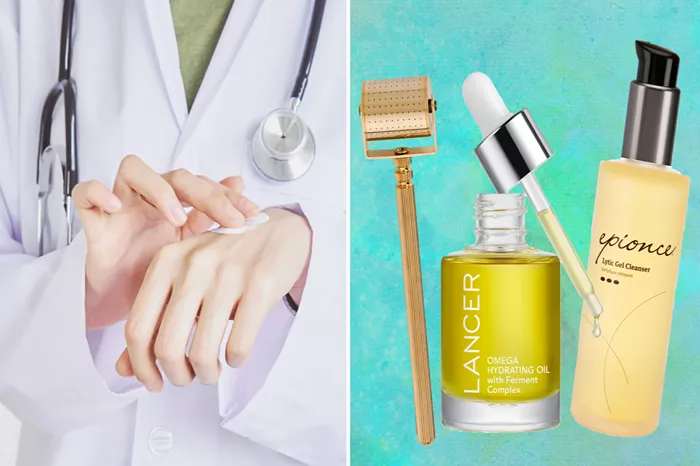In a world where skincare influencers dominate social media and beauty websites push the latest gadgets promising flawless skin, it’s tempting to try these devices at home. With claims of professional results at a fraction of the cost, many users think, “What could go wrong?” Unfortunately, a lot can go wrong, especially when these tools haven’t been reviewed for safety by the Food and Drug Administration (FDA).
Skin care professionals undergo years of training to determine the best procedures for their patients, considering factors like surgical history, pregnancy, scarring, medications, and even environmental factors. For instance, a dermatologist might advise against a chemical peel if you’re planning a beach vacation soon. Attempting these procedures at home can lead to severe skin damage.
HuffPost consulted four board-certified dermatologists to highlight eight popular skin care devices that you should think twice about using at home.
1. Microneedle Dermarollers
Microneedle dermarollers puncture the skin with tiny needles to stimulate collagen production and enhance serum absorption. While professional microneedling can help with hyperpigmentation and acne scars, at-home devices pose significant risks.
“There are so many things that can go wrong with at-home microneedling,” says Dr. Angela Casey, an Ohio-based dermatologist. “The at-home devices are never sterilized properly, and then the individual is puncturing their skin with the needles. This can introduce infection into the skin.”
Dr. Marisa Garshick, a New York-based dermatologist, adds that amateur microneedling lacks the precision of professional tools and can lead to skin irritation, scarring, or hyperpigmentation. “Since often the risks outweigh the benefits, it is preferred to do this procedure in an in-office setting,” she advises.
2. Pore Vacuums and Cupping Devices
Pore vacuums and cupping tools use suction to improve skin appearance by removing dirt and debris from pores. However, their benefits are often temporary and can cause more harm than good.
“Pore vacuums’ suctioning can cause bruising, broken blood vessels, and microtears in the skin,” warns Dr. Elaine Kung, a New York-based dermatologist. Despite claims that cupping improves blood circulation and collagen production, there is no scientific evidence supporting these benefits. Dr. Kung notes that cupping can cause bruising and broken blood vessels, making the skin look worse.
3. Chemical Peels
Chemical peels are popular on social media, with many users trying potent at-home versions. However, these peels can be dangerous without professional guidance.
“One must have a thorough knowledge of the skin condition being treated and the type of chemical peel that is selected,” says Dr. Casey. Different peels are used for acne, hyperpigmentation, and skin laxity, and using the wrong one can cause severe damage.
“Many peeling agents need to be neutralized, and if not properly neutralized, they can burn and damage the skin,” she explains. People using retinol products are at higher risk, as peels can penetrate deeper, causing irritation and burns.
4. Dermaplaning and Microdermabrasion Tools
Dermaplaning involves shaving the top layer of skin with a razor-like device, while microdermabrasion uses crystals to exfoliate. Both can be effective in professional settings but are risky at home.
“Home users are not trained on what settings to use on certain skin types and conditions,” says Dr. Jeffrey Hsu, a Chicago-based dermatologist. Using the wrong settings can lead to over-exfoliation, causing redness, irritation, and skin barrier damage. “People risk nicking, cutting, or infecting themselves with dermaplaning,” adds Dr. Kung.
5. Plasma and Hyaluron Pens
Hyaluron and plasma pens promise easy, at-home skincare procedures but carry significant risks. Hyaluron pens use high-pressure air to inject hyaluronic acid into the skin, which can lead to severe complications like permanent blindness and face paralysis if done incorrectly.
“The FDA recently issued a warning against using these devices for at-home use due to safety concerns,” says Dr. Garshick. “The material sold for these pens is not produced by actual pharmaceutical companies and has not been through an actual sterilization process,” adds Dr. Hsu. Non-sterile materials can cause tissue necrosis.
Plasma pens use electrostatic energy to remove skin tags, moles, warts, and age spots by essentially burning them off. “Any device that produces enough heat to remove skin can also severely scar or permanently pigment the skin if not used properly,” warns Dr. Hsu.
Use with Caution: 3 Devices to Handle Carefully
1. Facial Cleansing Brushes
Electric facial cleansing brushes can deeply cleanse the skin but may be too abrasive if overused. Dr. Hsu warns that hard bristles can compromise the skin, introducing bacteria and causing irritation.
2. Gua Sha Tools and Skin Rollers
Gua sha tools and skin rollers claim to improve circulation and collagen production. However, there’s no scientific evidence to support these claims, and aggressive use can worsen conditions like rosacea.
3. Light-Based Devices
LED light therapy devices claim to address issues like acne and fine lines. However, Dr. Casey cautions that improper use can exacerbate conditions like melasma and disrupt sleep patterns, which are crucial for healthy skin.
Conclusion
While at-home skincare devices can be appealing for their convenience and cost-saving promises, they often come with significant risks. Dermatologists recommend consulting with professionals before trying these tools to avoid severe skin damage and ensure safe, effective treatment.
Related topics:
Best 5 Laser For Pigmentation Removal
How Does Neutrogena Microdermabrasion Work?
Consumer NZ Calls for Ban on Sunbeds Amid Health Risks

